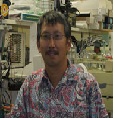Day 2 :
Keynote Forum
Li-Ming Chen
Huazhong University of Science and Technology, China
Keynote: Physiological roles of Na+/HCO3 – Co-transporters in intracellular pH regulation
Time : 09:00-09:25

Biography:
Li-Ming Chen received his BSc (1997) and PhD (2002) from PekingUniversity. He then received his Postdoctoral training at Yale University under thementorship of Dr. Walter F Boron. He obtained his first faculty position at the level of Instructor at Case Western Reserve University in 2008, and currently holds afaculty position at the level of Associate Professor at Huazhong University of Science & Technology in China. He has published a series of papers in top-tier journals, including PNAS, Journal of Physiology, Biology of Reproduction, FASEB J, Am JPhysiol, Neuroscience, Genomics, PLOS ONE, etc.
Abstract:
The solute carrier 4 family (SLC4), which includes the products of ten genes, plays critically important roles in the regulation of acid-base homeostasis. Among theten SLC4 members, eight are well established HCO3 – transporters, including threeNa+-independent anion exchangers (AE1−AE3) and fiveNa+-coupled HCO3 –transporters (NCBTs). The NCBTs consist of two electrogenic NBCe1 and NBCe2 aswell as three electro neutral NBCn1, NBCn2, and NDCBE. NCBTs are broadly expressed in diverse tissues in the body. The pathological significance of the NCBTs has been well established with the demonstrated association of dysfunctions of NCBTs with a series of human diseases, such as severe metabolic acidosis, epilepsy, migraine, mental retardation, visual abnormalities, bone formation defects, breast cancer, cardiovascular diseases, etc. In the present talk, I will discuss the structure and function of NCBTs. I will also discuss the latest progress in our study about the physiological roles of NCBTs in the kidney.
Keynote Forum
Tsung Chain Chang
National Cheng Kung University, Taiwan
Keynote: Molecular diagnosis of drug resistance of tuberculosisby a DNA array
Time : 09:25-09:50

Biography:
Tsung Chain Chang currently is a Professor at National Cheng Kung University, Tainan, Taiwan. His research focuses on developing chips for rapid diagnoses of human pathogens and drug resistance (tuberculosis). He has published about 90 SCI papers and obtained more than 40 patents issued from Taiwan, USA, the United Kingdom, France, Germany, and Australia. He also transferred several molecular diagnostic technologies to the biotechnology companies.
Abstract:
Tuberculosis (TB) is caused by Mycobacterium tuberculosis complex (MTBC) and is one of the world’s most important infectious diseases. According to World Health Organization, the annual incidences of new TB cases were 8.7 million and 1.4 million people died from TB. An alarming increase in the global incidence of drug-resistant TB has threatened the control and treatment of TB. Drug susceptibility of MTBC takes 3 weeks, resulting in deferred and inadequate treatment. Drug-resistant TB is associated with mutations in several genes, including rpoB for rifampin (RIF), katG and inhA regulatory region for isoniazid (INH), embB for ethambutol (EMB), gyrA and gyrB for fluoroquinolones [such as ofloxacin (OFX)], rrs, rpsL, and the promoter of eis for second-line injectable drugs [streptomycin (SM), kanamycin (KM), amikacin (AM), and capreomycin (CAP)]. An oligonucleotide array used to detect mutations of the aforementioned genes was developed. Specific oligonucleotide probes were designed to detect mutations in these genes. The assay consisted of multiplex PCR amplification, followed by hybridization of the amplicons with probes on a nylon membrane. A total of 204 patients were analyzed. The performance of the arraywere: sensitivities, 98.7% (RIF), 91.9% (INH), 84.6% (EMB), 85.3% (SM), 93.8% (OFX), 80% (KM), 60% (CAP), and 75% (AM), respectively; specificities, 100% (RIF), 99.0% (INH), 99.3% (EMB), 98.9% (SM), 100% (OFX), 100% (KM), 97.9% (CAP), and 100% (AM), respectively; positive predictive values, 100% (RIF), 99.0% (INH), 97.8 % (EMB), 98.9 % (SM), 100% (OFX), 100 % (KM), 60% (CAP), and 100% (AM), respectively; negative predictive values, 99.2% (RIF), 92.9% (INH), 95.0% (EMB), 85.4% (SM), 98.9% (OFX), 98.4% (KM), 97.9% (CAP), and 99.3% (AM), respectively. In conclusion, the array can effectively detect drug resistance of TB in a working day.
- Track 5: Biotechnology and Genetic engineering
Track 8: Cell, Micro and Molecular Biology
Location: Juniper Tree Room

Chair
Yong soo Kim
University of Hawaii, USA

Co-Chair
Nipunjot Kaur Soni-Bains
Khalsa College, India
Session Introduction
Yong soo Kim
University of Hawaii, USA
Title: Production of bioactive myostain propeptide of various animal species in E. coli.
Time : 10:50-11:10

Biography:
Yong Soo Kim has completed his PhD in the field of Animal Physiology from the University of California, Davis and Postdoctoral studies from Melbourne University. He is a Professor at the Department of Human Nutrition, Food and Animal Science, University of Hawaii, Manoa. His research area involved muscle growth and development and meat science and research activities in muscle biology area have focused on understanding the mechanisms involved in the regulation of muscle growth and development and improving animal growth rate and carcass composition.
Abstract:
Myostatin (MSTN) is a potent negative regulator of skeletal muscle growth in various animal species, thus there have been attempts to develop MSTN-inhibitory strategies to improve skeletal muscle growth in meat-producing animals as well as to treat muscle-wasting conditions in humans. MSTN propeptide (MSTNPro), the N-terminal part of unprocessed MSTN suppresses MSTN bioactivity by prevention of MSTN binding to its membrane receptor suggesting that MSTNPro is a potential candidate molecule to be used to suppress MSTN activity. To examine the potential of MSTNPro as an agent to improve skeletal muscle growth of meat producing animals in vivo, a large quantity of MSTNPro must be available. Since E. coli remains the most cost-effect system in high-yield production of recombinant proteins, we have attempted to produce bioactive MSTNPro in E. coli. Our first attempt demonstrated that rainbow trout MSTNPro was expressed in soluble forms using maltose binding protein as an N-terminal fusion partner. Affinity purified rainbow trout MSTNPro demonstrated MSTN-inhibitory activity in an in vitro assay system and the potency was not different from that of commercial mouse MSTNPro produced in a eukaryotic system. In subsequent studies, bioactive MSTNPro of chicken, pig and mouse were produced using the same E. coli system. Interestingly, MSTN-inhibitory potencies were different among MSTNPros from different animal species. The ability to produce MSTNPro in a cost effective E. coli system is expected to make it easy to investigate the potentials of MSTNPro as a pharmaceutical agent to improve skeletal muscle growth of meat producing animals.
Nipunjot Kaur Soni-Bains
Khalsa College, India
Title: Control of protease activity in S. pombe using gene silencing approach
Time : 11:10-11:30

Biography:
Abstract:
Amongst yeasts, the fission yeast Schizosaccharomyces pombe, is an attractive host model for high-level protein production and functional analysis of eukaryotic proteins as it shares many molecular, genetic and biochemical features with higher eukaryotes such as plants and animals, and is distinguishable from other yeasts through its ability to proliferate by fission rather than budding. Furthermore, S. pombe has a developed Golgi apparatus and galactosy ltransferase that is not found in other yeast cells. However, one of the major hurdles in efficient production and purification of heterologous proteins from S. pombe is proteolytic degradation of the recombinant gene products by host-specific proteases. The problem becomes significant when the recombinant protein under production, is secretory and proteolytically sensitive in nature. Present study aims at controlling the protease activity by gene silencing approach. RNA silencing is an evolutionarily conserved gene regulatory mechanism with many species-specific variations by which double stranded RNA (dsRNA) causes sequence-specific degradation of mRNA sequences. It has become a powerful tool for genetic analyses and is likely to become a potent therapeutic approach for gene silencing. A Protease silencing cassette was designed to impede the protease enzyme post trascriptionally. Since all proteases do not attack all proteins, only protein specific protease is sought to be silenced as a test case in this study. Human Parathyroid hormone having a chain of 115 AAs was selected as model protein and the silencing of protease responsible for its degradation was studied as a test case.
Risheng Wang
Missouri University of Science and Technology, USA
Title: The Fabrication of DNA Nanostructures and Their Applications in Bionanotechnology
Time : 11:30-11:50

Biography:
Risheng Wang has completed her PhD in 2010 from New York University. She then joined, as Postdoctoral research associate, the Department of Chemistry and Applied Physics and Applied Mathematics (APAM) at Columbia University. After which she became an Assistant Professor at Chemistry department of Missouri University of Science and Technology. She has published a series of papers in reputed journals.
Abstract:
Deoxyribonucleic acid (DNA), as you may very well know, is the carrier of generic information in living cells, which can replicate itself through Watson-Crick base paring. However, over the past three decades, researchers in the emerging field of DNA nanotechnology have been using the DNA as structural nanomaterials, based on its unique molecular recognition properties and structural features, to build addressable artificial nanostructures in one, two and three dimensions. These self-assembled nanostructures have been used to precisely organize functional components into deliberately designed patterns which have a wide application potential in material science, biomedical, electronic and environmental fields. The development of DNA nanotechnology and its potential application will be covered. Then this talk will discuss the design and construction of several DNA nanostructures, including self-assembly of DNA six-helix nanotubes from two half-tube components; Using DNA origami template to organize semiconducting quantum dots (QDs) and gold nanoparticles (AuNPs) and discussing the methods to integrate “top-down” nanofabrication technique with “bottom-up” self-assembly.
M Krishnan
Bharathidasan University, India
Title: Molecular characterization of vitellogenin receptor from Bombyx mori and Spodoptera litura: As a tool for pest management
Time : 11:50-12:10

Biography:
Abstract:
In the everlasting races against the pests of agricultural importance, it is essential to develop a novel strategy for pest control. For this a thorough understanding of biological system of the insect pest at the cellular and molecular levels is needed. For instance, the recent trend involves the identification and characterization of physiologically and metabolically important proteins like insect vitellogenin, vitellogenin receptor, storage protein and apolipoporin which can be subjected to various refinements and manipulations for exploitation in pest management, in a target specific and eco-friendly manner. In the present investigation, we have studied the vitellogenin and vitellogenin receptor interaction. The N-terminal Ligand Binding Domain (LBD) of vitellogenin receptor is responsible for the transportation of vital protein (Vitellogenin) to the developing oocyte through receptor mediated endocytosis pathway. Ligand binding domain (LBD) sequence of B. mori noted to be completely different with that of Spodoptera litura though these two insects are coming under the lepidopteran group.The motif in the LBD were also species specific. VgR LBD from B. mori and S. litura were isolated and cloned in pET30a+ vector for over expression for structural studies. Since both insect with same order but LBD differences have pave way for understanding and implementing a new approach for species specific target drug development to inhibit the binding of Vg to the receptor specific to insect pest Spodoptera litura without affecting non targeted system.
Michihiko Kobayashi
University of Tsukuba, Japan
Title: Vectors based upon unique gene regulatory mechanims
Time : 12:10-12:30
Biography:
Michihiko Kobayashi obtained PhD from Kyoto University in 1991 and started his professional career in Kyoto University (1991-1999; as Assistant Professor and Associate Professor etc). In 1999, as Professor, he started the lab of Molecular Microbial Bioengineering at University of Tsukuba.
Abstract:
Expression systems are essential tools for production of recombinant proteins in cells and for analyses of the function of unknown genes or proteins. We have investigated microbial metabolism of nitrile compounds through the following two enzymatic pathways: nitrile hydratase hydrating nitrile to the corresponding amide; nitrilase hydrolyzing nitrile to the corresponding acid and ammonia. An actinomycete produces the both nitrile-converting enzymes, depending on the corresponding inducer. Nitrilase and nitrile hydratase are inductively overexpressed by adding nitrile and amide, respectively, to the culture media. We clarified the regulation mechanisms of the both enzymes at protein, DNA and RNA levels. The characteristics of the strong promoters of these enzyme genes are promising for the design of a new expression system. Using each of these regulation mechanisms and the strong gene promoters of the both enzymes, we succeeded in the construction of expression systems in microorganisms. We made the vector with the nitrilase system functioning an actinomycete as a host microorganism, which has been for the manufacture of useful compounds. Another vector includes the other nitrile-converting enzyme system functioning in actinomycetes, which have widely been for the production of biologically active compounds. Diverse restriction sites are available within the multi-cloning site of each vector.
Govindasamy Chandramohan
King Saud University, Saudi Arabia
Title: The bioflavonoid kaempferol attenuates circulatory lipids in experimental diabetic rats
Time : 12:30-12:50

Biography:
Govindasamy Chandramohan has completed his PhD from Annamalai University, India. He is currently working as an Assistant Professor in the Department of Community Health Sciences, College of Applied Medical Sciences, King Saud University, Saudi Arabia. He is having one patent for his novel antidiabetic drug invention. Senior Research Fellowship and University Research Studentship have been awarded for his doctoral research by Indian Council of Medical Research and Annamalai University respectively. He is very active in participation in scientific meeting and he has attended many scientific meetings. He has also served as a Session Chair Person and organizing committee member in various scientific international meetings. He has published a good number of papers in reputed international journals. He is serving as an Editorial Board Member and reviewer in reputed journals.
Abstract:
Flavonoids have anti-inflammatory and antioxidative effects and thus may protect against diabetic complications. Diabetes mellitus is associated with dyslipidemia, which is a significant risk factor for cardiovascular complications. This study was designed to investigate the effect of kaempferol on plasma and tissues lipid profiles in streptozotocin-induced diabetic rats. Diabetes was induced in adult male albino rats of the Wistar strain, weighing 180–200 g, by administration of streptozotocin (STZ) (40 mg/kg of body weight) intraperitoneally. The increased levels of plasma glucose and decreased levels of insulin were observed in diabetic rats and treatment with kaempferol significantly decreased the plasma glucose and increased the insulin levels towards normalcy. The levels of total cholesterol, triglycerides, free fatty acids and phospholipids were assayed in the plasma and tissues (liver, kidney and heart) besides lipoprotein-cholesterol (high density lipoprotein-cholesterol (HDL-C), low density lipoprotein-cholesterol (LDL-C) and very low density lipoprotein-cholesterol (VLDL-C)) were assayed in plasma. Total cholesterol, triglyceride, free fatty acid and phospholipid (LDL-C and VLDL-C in plasma only) levels significantly were increased in plasma and tissues, while plasma HDL-cholesterol significantly decreased in diabetic rats. Treatment with kaempferol prevented the above changes and improved towards normalcy. These results indicate that kaempferol can potentially ameliorate lipid abnormalities related to the risk of diabetes mellitus.
Zaneta Matuszek
University of Warsaw, POLAND
Title: Analysis of 5’ and 3’ snoRNA termini maturation in Saccharomyces cerevisiae
Time : 13:35-13:50

Biography:
Zaneta Matuszek is a Graduate student of the College of Inter-faculty Individual Studies in Science and Mathematics at the University of Warsaw (Poland). She is involved in two majors: Biotechnology and Chemistry. Since 2011 she has been working in the Institute of Genetics and Biotechnology, University of Warsaw, in a Professor Kufel’s lab of RNA metabolism in Eukaryotic cells. She is the Organizer of the International Conference Aspects of Neuroscience held annually in Warsaw. Since January 2014 she has been a leader of her own research project granted by “GeneracjaPrzyszÅ‚oÅ›ci” Polish Ministry of Science and Higher Education Funding Program.
Abstract:
Small nucleolar RNAs (snoRNAs) are the best characterized non-coding RNAs transcribed by RNA polymerase II. They are produced as precursors, whose extended 3’ ends are trimmed exonucleolytically whereas 5’ ends either undergo combined endo and exonucleolytic processing by Rnt1 and Rat1 respectively or remain unchanged. In the latter case, the m7G cap becomes hypermethylated by Tgs1.cRT-PCRand northern blot analyses suggest that processing of snoRNA 3' and 5' termini is tightly coupled. Inhibition of 5’ end maturation in rnt1Δ strain cause the accumulation of snoRNA precursors that do not possess mature 3’ ends but carry polyadenylated extensions. This defect is further increased when components of the cap-binding complex (CBC) or methyltransferase Tgs1 are missing. Although we observe an accumulation of pre-snoRNAs in rnt1 strain, there are also mature snoRNAs present. These results suggest the existence of an alternative pathway of 5' end processing that most likely involves pre-snoRNA cap removal by Dcp1/Dcp2 complex. Interestingly most pre-snoRNAs that accumulates in dcp2Δ strains are not cleaved by Rnt1 which was confirmed by 5´ RACE analysis.Obtained data strongly suggest the existence of a quality control mechanism that coordinates 5’ and 3’ end processing.
Jian JIN
Université de Nantes, France
Title: Kinetics of biomass and hydrocarbon oils production of microalgae Botryococcus braunii in continuous culture
Time : 13:50-14:05

Biography:
Jian Jin is a PhDstudent in lab of GEPEA, University of Nantes, France. He has completed his Master’s degree from Renmin University of China (Majoring in Food Science, 2012) and Bachelor's degree from China Agricultural University (Majoring in Bio-engineering, 2010). He is interested in cultivation of microalgae in bioreactor for production of biofuels and other high value products.
Abstract:
Botryococccus braunii as one of the most outstanding green microalga attracts increasing attention. It can biosynthesize high content of hydrocarbons oils reaching 50% of dry weight or more and secrete them out of cell. Hydrocarbons oils in B. braunii are similar to those found in petroleum which is regarded as one of the most readily available source for converting into biofuels. During the recent years, a lot of papers have described some growth characteristics and hydrocarbon production as a function of different conditions. Even though progresses have been made, the hydrocarbon productivity is still relatively low and not already cost-effective for industry production. In addition, most of the studies were carried out in batch cultures for relative short durations. There are few studies of continuous culture of B. braunii. The objective is to gain better knowledge and understanding of the underlying physiological processes in relation to hydrocarbons production which accumulate in an extracellular matrix. In this study, kinetic studies started by cultivation of a strain of B. braunii within a full controlled photo-bioreactors. Under steady state regimes, the effects of different cultural factors on the kinetics of biomass and hydrocarbon oils (total lipids and purified hydrocarbon) production in relation to changes in the rates of some physiological reactions were studied. Such experimental data could beimportant for further improvement of culture conditions and culture systems for high biofuel productivity.
- Track 3: Pharmaceutical Biotechnology
Track 10: Marine Biotechnology

Chair
Li-Ming Chen
Huazhong University of Science and Technology, China

Co-Chair
Zhijun Li
University of the Sciences, Philadelphia, USA
Session Introduction
Zhijun Li
University of the Sciences
Philadelphia, USA
Title: PyMine - A PyMol plugin to integrate and visualize chemical and biological data for drug discovery
Time : 09:50-10:10

Biography:
Zhijun Li has received his Ph.D. degree from Vanderbilt University in 2000 and undergone postdoctoral training at Massachusetts Institute of Technology and Vanderbilt University. He is currently the associate professor of bioinformatics at University of the Sciences, formerly Philadelphia College of Pharmacy. He has published more than 28 papers in peer-reviewed journals and has been awarded a number of grants by various funding agencies for his research on protein structure and function prediction and computer-aided molecular design. He has been a reviewer for a variety of scientific journals and funding agencies including NSF.
Abstract:
Tremendous amount of chemical and biological data are being generated by various high-throughput biological techniques which could facilitate modern drug discovery. These data include protein sequences, protein three-dimensional structures, single amino acid variations (SAV), known ligands and substrates of proteins, and pathways. Currently, these data are classified and deposited into various chemical-informatics and bio-informatics databases based on the data type. However, the lack of integration makes it very challenging for individual scientist to access and understand all the data related to a specific protein of interest. We developed a bioinformatics tool, PyMine, which extracts various chemical and biological data from a variety of high-quality databases and presents them in a graphic and uniformed way. The primary databases accessible by PyMine include protein UniProt database, KEGG pathway database, PDB macromolecule structure database, ChEMBL database of small ligands, IBIS database of protein binding sites and HUMSAVAR database of SAVs. Users input the PDB ID of the protein of interest, all related data will then be extracted and whenever possible, mapped to the three-dimensional structure of the protein. Thus, PyMine can be used as a central data-hub to visualize and access various types of data related to the protein of interest as well as to develop new idea for structure-based molecule design. For convenience, PyMine was developed as a plugin of PyMol, a popular and free graphic modeling tool.
Raghuvir R. S. Pissurlenkar
Goa College of Pharmacy
INDIA
Title: QSAR Methodologies for Peptide Design
Time : 10:10-10:30

Biography:
Raghuvir has completed his PhD (Tech) from Bombay College of Pharmacy, Mumbai University in Pharmaceutical Chemistry. He has worked at Bombay College of Pharmacy as an Assistant Professor of Pharmaceutical Chemistry from January 2006 till September 2014. At present he is an Associate Professor, Pharmaceutical Chemistry at Goa College of Pharmacy, Panaji Goa. He’s area of research include Structure-based Ligand Design, Protein Modeling and Bio-molecular Simulations. He has 2 patents, 28 international and 4 national papers to his credit.
Abstract:
Peptides play a significant role in the biological world. Optimization of peptide activity for a specific therapeutic target is a daunting task; owing to time and cost factor involved in the process. Specific computational approaches can simplify the task to elucidate the structural basis in the design of new peptides. Peptide QSAR approaches highlighted here being with simple Classical Hansch and Free-Wilson QSAR technique based models that make use of the amino acid properties (literature compiled or calculated theoretically) as X-variables to correlate the biological activity. The mathematical models so developed can explain and predict the position-wise specific nature and type of amino acids for a given peptide sequence (QCS 2007, 26, 189). Uncertainties associated with the 3D-alignment of peptides in 3D-QSAR can be reduced by an approach coined as HomoSAR. The concept is centered on the homology modelling principles to result in 1D-alignment of the peptides though a multiple sequence alignment; followed by computation of position-wise similarity indices for amino acids in the peptide sequences. (SRE, 2008, Article ID 360572, 1; JCC 2013, 34, 2635). The third peptide QSAR approach referred to as ensemble QSAR (eQSAR) addresses the conformational ensemble issue as an improvement to the classical ‘one chemical–one structure–one parameter value’ dogma. The X-variables are calculated for the conformational ensemble for all peptides generated through molecular dynamic simulations. These descriptors (PD-Eigen values) are computed over Physicochemical Distance matrices (PD-matrices) that are unique to every conformation of every peptide; subsequently correlated to the biological activities. All the approaches have been tested on peptide datasets to put forth statistically validated QSAR models (JCC 2011, 32, 2204).
Niranjan Koirala
Sun Moon University, Republic of Korea
Title: The choice of rhamnetin, sakuranetin and genkwanin as nutraceutical, pharmaceutical and cosmeceutical agents
Time : 10:50-11:10

Biography:
Niranjan Koirala is pursuing his PhD under the supervision of Professor Sohng at Sun Moon University, South Korea. He has been working at the Department of Pharmaceutical Engineering and his major research focus is modifications of plant secondary metabolites by glycosylation and methylation using engineered E. coli. The compounds produced in the reactors are tested for anti-microbial and anti-cancer assays in the laboratory conditions. He has published around 10 international papers as author and co-author.
Abstract:
Rhamnetin, sakuranetin and genkwanin are uncommon plant secondary metabolites and have been suggested to be potent pharmaceutical agents by some research groups. Evidences were based on the findings conducted on rat models, lung cancer cells, nasopharyngeal carcinoma cells and many in vivo and in vitro experiments. We also conducted several experiments in vitro and found out these compounds were more potent than their original counterparts; quercetin, naringenin and apigenin respectively. While these results sounds promising and worthy of further investigations, we speculate that these compounds warrant further investigation in vivo as potential new therapeutic anti-carcinogenic, anti-melanogenic and anti-angiogenic agents. We want to draw the attention of the nutraceutical, pharmaceutical and cosmeceutical communities.
Mani Kannan
Bharathidasan University, India
Title: Purification and Biophysical characterization of 37 kDa serine protease zymogen from silkworm, Bombyx mori
Time : 11:10-11:30
Biography:
Abstract:
Numerous enzymes have been synthesized as a zymogen in different stage and activated time-specific manner in many insect pests for its growth and development. Particularly, 37kDa serine protease was synthesized as a zymogen precursor in the midgut and activated upon pupation of B.mori. 37 kDa serine protease encodes a 37 kDa composed of 329 amino acid which is playing a critical role in the process of digestion of food and physiological process including apoptosis and tissue remodelling in B.mori. To purify and characterize the 37kDa serine protease, it was over expressed by using PET30a expression vector in Escherichia coli (BL21 DE3) with N-terminal His6-tag. The over expressed His-tag protein was successfully purified using Ni-NTA and observed as a single band with a molecular mass of 42.5 kDa on SDS-PAGE. The pI of the purified protein was found to be three major spots between the pI of 6.2 to 6.8 with MW 45kDa were determined by using 2D-PAGE. The resulted protein spots were also confirmed by MALDI-TOF-MS analysis. Circular Dichroism showed that 37 kDa serine protease zymogen was consistent over the range of 6-7 for the pH, with approximately half of the protein having well-defined α-helical and β-sheet secondary structure. The composition of purified p37k serine protease was analysed using HPLC. Computational prediction of cleavage site for signal peptide and propeptide of 37 kDa serine protease between positions of 18-19, 35-66 aa respectively were determined through SignalP-4.1 tool. This result revealed that pI/Mw of active protease of 37kDa serine protease after removal of pro-peptide showed 5.91 / 28007.38. This overall results revealed that the complex structure of this protease reasoned for inactive zymogen and slightly acidic pH at (>5) plays a major role in activation 37 kDa serine protease in the midgut for tissue remodelling during pupation or anti-feeding stage. In future, the identification of zymogen (pro-protein) processing enzyme will be much helpful for the development of novel drug/pesticide for the control of insect pests.
Arunachalam Chinnathambi
King Saud University, Kingdom of Saudi Arabia
Title: Analysis of the phytochemical constituents of Mimosa pudica and determination of their antimicrobial activity
Time : 11:30-11:50
Biography:
Arunachalam Chinnathambi has completed his PhD from Bharathidansan University, India and has trained few molecular techniques from National University of Singapore. He is a young, energetic and enthusiastic Microbiologist and has 11 years’ experience in both Teaching and Research. He has participated in several international, national conferences, symposia and presented research papers and recently he presented his novel research in University of London. He has published more than 41 papers in reputed national and international journals and serving as an Editorial Board Member of reputed journal and also has lifetime membership of few Microbiology associations.
Abstract:
Mimosa pudica plant leaves were collected from Thanjavur District, Tamil Nadu. They were air-dried and ground and their phytochemical composition determined. The analysis demonstrated the presence of tannin, phlobatannins, saponin, steroids, terpenoids and the cardiac glycosidem while no flavonoids were found. Thirteen phytochemical compounds were identified by GC-MS analysis, most of which are known to possess a variety of medicinal properties. A soxhlet apparatus was used to extract antibacterial active compounds from the powdered plant leaves and the antimicrobial activity of the extract were analyzed against some human pathogenic bacteria. Acetone and ethanol extracts were found to be the most active. Compared to other test plant-extracts aqueous extracts however exhibited only limited inhibition against the tested organisms. The findings will hopefully be useful in helping to develop new and effective antimicrobial agents.
- Track 6: Industrial Biotechnology
Track 4: Environmental Biotechnology
Track 11: Bioinformatics and Biosensors
Location: Juniper Tree Room

Chair
Zhijun Li
University of the Sciences, Philadelphia, USA
Session Introduction
Simair A. Altaf
Donghua University
Shanghai, China
Title: Characterization of crude Xylanase produced by edible mushroom Pleurotus eryngii
Time : 09:00-09:20

Biography:
Abstract:
Xylanases has been increasingly forthcoming in recent years because of their possible involvement in numerous industrial processes including bioconversion of lignocellulose drived sugars in to fuels, processing food and the paper and fibre industries. Edible mushrooms are emerging as important source of xylanolytic enzymes and this study has concentrated to produce and characterize xylanases by pleurotus eryngii. The crude enzyme was characterized on the basis of various parameters such as incubation time, substrate specificity, substrate concentration, enzyme volume, buffer, pH, pH stability, temperature, temperature stability, and effect of various metal ions or compounds. The xylanase activity was noted maximum at 15 minutes of incubation time, 2.0% xylan and 0.5 ml enzyme volume. The highest enzyme activity was found at pH 4.5, whereas xylanase exhibited maximum stability in the range of pH 4.0 to 10.0. The maximum xylanase activity was noted at 60ËšC, while enzyme was most active and retains more than 40% activity at 90°C with in 10 minutes of incubation. ZnCl2 (10mM) stimulated the xylanase activity as compare to other metal ions or compounds. It is concluded that Pleurotus eryngii is capable to produce pH stable and thermostable xylanase for industrial purposes.
Felix Lenk
Dresden University of Technology, Germany
Title: How can bench-top lab automation systems speed up the development of bioprocesses – Current solutions and future prospects
Time : 09:20-09:40
Biography:
Felix Lenk is Group head the Institute of Food Technology and Bioprocess Engineering, Dresden university.
Abstract:
Laboratory automation was, also due to devices sizes and technologies used, often unavailable to small and middle sized laboratories. However based on the constant development in automation engineering innovative components offer endless possibilities for an engineering of bench-top devices for laboratory automation. In order to improve the development of bioprocesses and routine tasks in microbiology labs the most current technologies are presented. A fully automated solution for nutrient medium preparation with a volume of up to 2 L is currently developed at the Chair of Bioprocess Engineering at the TU Dresden. The device is fully compliant to the guidelines for laboratory devices and produced batches can be tracked (GMP-compliant). With this solution for the automation of nutrient medium preparation the risk of human errors is consequently lowered and the quality of medium preparation is expedited. Users select the appropriate recipes for the nutrient medium from the data-base and after 7 minutes the medium preparation is completed. The PetriJet, also developed at the TU Dresden, aims at all processes associated with culture dishes and can handle more than 100 culture dishes automatically with a patented multi-functional mechanical gripper. The gripper allows to perform various tasks in conjunction with different processing stations such as imaging of cultures dishes using the PetriCam tripod, filling of empty culture dishes with nutrient medium or even transferring samples from on culture dish to another. A unique feature of PetriJet is a processing station that provides real-time stereo images using a stereo camera setup. The integrated software allows a reconstruction of the 3D-image and extensive image analysis for parameter extraction. Many standard tasks in laboratory environments have the potential for an automated solution that fits on one standard work-bench. The authors present a detailed comparison between manual work and the respective prototype automation solution as well as commercial products already available to the market based on a field study finding that the presented lab automation solutions typically enable for a 4 times higher sample throughput while cutting down labor cost by about 75 %.
Alexey Safonov
Russian Academy of Sciences, Russia
Title: Flow-Through Bioreactor For Radioactive Waste Purification
Time : 10:40-11:00
Biography:
Alexey Safonov has completed his PhD in Ecology and he is a Senior Researcher, Head of Biotechnology and Radioecology group in Frumkin Institute of Physical Chemistry and Electrochemistry of Russian Academy of Science. His interests are: Microbiology of radioactive waste repositories, biogeochemistry and in situ bioremediation, bio-treatment of waste, radioecology, uranium mill tailing, bacterial fungal and algae abilities for metal sorption and reduce, flow-through bio-filters, bio-electrochemistry and biosensors, Tc chemistry, trans-uranium radionuclides and fission products and radio medicine.
Abstract:
Liquid radioactive wastes (LRW) are multi-component systems which contain various macro components like nitrate solution (with the concentration of nitrate ions up to 300 g/L), sulfate ions, extractants, solvents, detergents and well as micro components-uranium series radionuclides, fission products (cesium, strontium, technetium, ruthenium, etc.), tritium and corrosion products.Themain problem in implementation of the core technologies of conditioning and long-term storage of radioactive waste ispresence of huge amount of nitrate ions.The aim of the present work was the utilization of denitrifying bacteria at the stage of waste denitration prior to cementation. Biological denitrification takes place viarespiration process whereby, nitrate ions are reduced to nitrogen through a series of intermediates.The microorganisms separated from extreme habitats: Pseudomonas putida (ecosystems contaminated with radioactive waste, dadwaste repository “Severniy”), Halomonas mono(alkaline lakes of Kulunda steppe with a total salt content of up to 300 g /L and pH 9-11) and Shevanella putrefactions strain from underground water contaminated with nitrate and radionuclides were studies. All strainspossess ability to reduce nitrate anions to molecular nitrogen and metals from high to low valence state.On the base of the data obtained from FSUE “RADON” analytical laboratory the model solutions with the following composition nitratesconcentration 4-100 g/L, sulfates up to 2 g/L, bicarbonate HCO3− up to 10 g/Land pH 9-10were prepared. Laboratory designed biofilters with different types of cultivation (in static and flow-through conditions) were applied. As source of carbon and electron donors for cell respiration saccharose in proportion of 1:1,to nitrate ions was used.The content of nitrate, nitrite in solutions and COD parameterswereanalyzed on supply and outlet points of flow-through biofilter in a 1 per 10 min discrete mode.After cultivation under the static conditions (batch mode) the concentration of nitrate ions decreased by factor 2 to 5. During the cultivation in the flow-through biofilter system the rate and degree of nitrate consumption has significantlyincreased via formation of a surface biofilm on an inert carrier providing higher specific surface.Bacterial cells were able to immobilize radionuclides from the solution U (88-96%), Th (up to 90 %),Sr (50-60 %), Tc, Cs and toxic metals Cr, V, Mo, Lacontributing to complex purification of radioactive waste

Biography:
António Maximiano Fernandes has completed his MSc at the age of 28 years from Jiangnan University. He is medical pathologist and food scientist researcher, developing the first real application of highly sensitive genosensor, which has several applications. The main advantage of this research is the superior sensibility application of nanomaterial in real samples detection. Recently he plane to combine electronics and real time samples detection, and papers has been accepted in high reputed journals, such as Biosensor and Bioelectronic (UK) and Journal of Agriculture and Food Chemistry (USA).
Abstract:
In this paper, we reported the construction of new high sensitive electrochemical genosensor based on multiwalled carbon nanotubes-chitosan-bismuth complex (MWCNT-Chi-Bi) and lead sulfide nanoparticles for the detection of pathogenic Aeromonas. Lead sulfide nanoparticles capped with 5`-(NH2) oligonucleotides thought amide bond was used as signalizing probe DNA (sz-DNA), and thiol-modified oligonucleotides sequence was used as fixing probe DNA (fDNA). The two probes hybridize with target Aeromonas DNA (tDNA) sequence (fDNA-tDNA-szDNA). The signal of hybridization is detected by differential pulse voltammetry (DPV) after electrodeposition of released lead nanoparticles (PbS) from sz-DNA on the surface of glass carbon electrode decorated with MWCNT-Chi-Bi, which improves the deposition and traducing electrical signal. A new ssDNA probe and primers specific for the fragment Aerolysin gene (aer) was designed and the optimization of incubation time, hybridization temperature, deposition potential, deposition time and the specificity of the probes were investigated. Our results showed the highest sensibility to detect the target gene when compared with related biosensors and Polymerase Chain Reaction (PCR). The detection limit for this biosensor was 10-14 M. We could detect lower than 102 CFU mL-1 of Aeromonas in tap water. This method is rapid and sensitive for the detection of pathogenic bacteria and would become a potential application in biomedical diagnosis, food safety and environmental monitoring.
Adejimi A.A
Tshwane University of Technology
South Africa
Title: SPECIATION OF CHROMIUM AND VANADIUM IN MEDICINAL PLANTS IN THE VICINITY OF FERROCHROME AND VANADIUM SMELTERS
Time : 11:20-11:40
Biography:
Abstract:
There exist abundant evidence globally that anthropogenic activities have polluted the environment with heavy metals such V(V), which eventually find their way into the human food-chain with the subsequent adverse effects. In this study, the graphite furnace atomic absorption spectrometry (GFAAS) was used in the determination of V(V) and total V in medicinal plants collected from the farm in the vicinity of the vanadium smelter but unable to sampling the medicinal plants near ferrochrome smelter. The determination of V(V) in medicinal plants by (GFAAS) was applied based on their leaching with 0.1 M Na2CO3. The solution was filtered through a PDVF 0.45 mL hydrophilic filter prior analysis by GFAAS. The results suggest that the pyrolysis temperatures of 1300ï‚°C - 1500ï‚°C are effective to eliminate the majority of the matrix prior to atomization and any residual amounts of Na2CO3 had no influence on the release of V during atomization.
- Track 1: Food BiotechnologyTrack 2: Biotechnology in Agriculture

Chair
D.H.Tejavathi
Bangalore University, India
Co-Chair
Raveesha H.R
Bangalore University, India
Session Introduction
D.H.Tejavathi
Bangalore University,
India
Title: Utilization of AM fungal association for sustainable cultivation of mulberry (Morus indica L.)
Time : 14:10-14:30

Biography:
She is working as UGC-BSR Faculty Fellow in the Department of Botany, Bangalore University, India. She has published 78 research articles in various national and international journals and completed 8 research projects funded by DST, CSIR, BU-UGC and MoEF, India. She has successfully guided 20 research students for Ph.D degree and 15 students for M.Phil degree. She was conferred with an award ‘Merit of Excellence’ for outstanding contribution to the Medicinal plant research during the 4th international conference on Medicinal plants and herbal products held at John Hopkins University, Rockville, M.D, USA,2012.
Abstract:
Morus indica var. Mysore local is comparatively low yielding. However, its adoptability to low agronomic inputs and poor management practices both under rain fed and irrigated condition make this variety sustainable even though several high yielding varieties are released in the past few decades. Therefore, it is essential to genetically improve the var. Mysore local in respect of better establishment and yield by employing alternate strategies like tissue culture and utilization of AM fungi. Multiple shoots were obtained when nodal segments were cultured on MS supplemented with auxins and/or cytokinins. Thus obtained shoots were rooted on 1/4th strength MS+IBA/NAA. The plantlets were sequentially acclimatized by transferring them to soilrite mixture (Peat:Peralite:Vermiculite- 1:1:1 ratio) in bottles and then to pots containing sterilized soil. One month old normal and micropropagated plants were treated with Glomus mosseae and G.fasciculatum. The micropropagated plants treated with G.fasciculatum were found to be superior in growth performance, contents of primary metabolites, macro and micronutrients than other treatments and control. The leaves showed significantly high percent of moisture content and moisture retention capacity - main determinants of leaf quality. When the silkworm larvae fed with leaves of micropropagated plants treated with G.fasciculatum rearing, grainage and reeling parameters were found to be superior to other samples. Conclusion can be drawn from the present studies that the tissue culture coupled with mycorrhization is an alternate strategy to improve this taxon which is known for its adaptation for low agronomic inputs and can be recommended for cultivation in the areas where there is shortage of rainfall.
H.R. Raveesha
Bangalore University
India
Title: Influence of AM fungi on accumulation of withaferin-A in micropropagated Withania somnifera (L.) Dunal
Time : 14:30-14:50

Biography:
He is working as Assistant Professor, Dept. of Botany, Bangalore University, Bangalore since 2003. He has obtained Ph. D degree from Bangalore University under the guidance of Prof.D.H.Tejavathi in 2003. He has published more than 16 papers in National and International Journals and participated and presented papers in 29 National and International Conferences. He is actively involved in the major research project sanctioned by DST, MoEF and minor project from BUIRF. He organized the National Conference on Plant Biology, September 2013 in the Department and also serving as different academic member in various Universities.
Abstract:
Withania somnifera, belonging to the family Solanaceae, is an important medicinal herb of India with restricted geographic distribution. It is a rich source of withaferin-A and other bioactive withanolides. In the present study a rapid in vitro mass propagation protocol of W. somnifera was developed from shoot tip, nodal and leaf explants. The explants were cultured on MS medium supplemented with various concentrations and combinations of plant growth regulators. In vitro raised shoots were further rooted on half-strength MS medium containing 1mgl-1 of IBA. The root samples of normal (T1), in vitro regenerated (uninoculated, T2) and G. mosseae (T3), G. fasciculatum (T4) and G. macrocarpum (T5 ) micropropagated treated plants were used to study the effects of arbuscular mycorrhizal fungal association to enhance the production of Withaferin-A compared to control plants. The HPLC analysis revealed significant differences in the yield of Withaferin-A in Glomus treated plants (81.60, 76.64, 75.06, 73.42 and 69.55 mg/gm) over control plants (63.25 and 57.70 mg/gm). The high percentage of root colonization in AMF inoculated in vitro plants must have resulted in better growth of plants and production of Withaferin A. The results of this study suggested that AMF have the potential to influence yield and nutrient content of in vitro regenerated Withania somnifera in a greenhouse conditions.
D.R.Jayashree
M.S.Ramaiah College of Arts, Science and Commerce
Bangalore
India
Title: Effect of Arbuscular mycorrhizal symbiosis on biosynthesis of active ingredients in selected Medicinal plants
Time : 14:50-15:10

Biography:
She is Assistant Professor in Department of Biotechnology, M.S.Ramaiah College, Bangalore, India with 17 years of teaching experience. She has participated in several National and International Conferences in India and abroad and presented papers, of which one was adjudicated as the best paper of the session at a 4th international conference on Medicinal plants and herbal products held at Johns Hopkins University, Rockville, and M.D. USA. 2012 and best Poster presentation at national conference, 2013, Dept. of Botany, Bangalore University. Bangalore. Presently she is pursuing Ph.D. Degree under the guidance of Prof. D.H. Tejavathi, Department of Botany, Bangalore University.
Abstract:
Medicinal plants are the raw materials for isolation of the pure active compounds for formulations into drugs, as intermediates in the production of semi-synthetic drugs and for preparation of standardized galenicals. The improvement in quality and quantity can be made with the application of Biofertilizers, the AM fungi, one of the important beneficial microorganisms of the soil edaphon in most agro-ecosystem. The present work is focused on the efficiency of the interactions between AM fungi and selected medicinal herbs on growth performance and principle compounds. Euphorbia hirta, Eclipta alba, Leucas aspera and Achyranthus aspera, were inoculated with various AM fungi - Aculospora bireticulata, A.laevis, A.lacunosa, Glomus aggregatum, G.geosporum, G.fasciculatum and G.mosseae to analyze the principle compounds of the host plants and AM fungal host specificity. The well known principle compounds of the selected taxa were elucidated by HPLC. Results have revealed positive effect of AMF inoculation on growth parameters in treated medicinal herbs compared to uninoculated control. All the AM fungal species significantly increased the concentration of Wadelolactone, Leucasperol, Quercitrin and Betaine in AM fungal treated plants. However the contents vary with the species. E.alba treated with G.aggregatum and E.hirta and L.aspera with G.mosseae showed enhanced levels of principle compounds. Whereas, G.fasciculatum has significantly improved the contents of active principles confirming the host specificity of AM fungi. These wild crafted, non-conventional leafy vegetables particularly are good source of antioxidants for a regular diet and are of higher nutraceutical values. This could impact on human health, cost of welfare and even on the revenue for the producer.
R.V. Madhusudhan
Bangalore University
India
Title: In vitro micropropagation of Calamus huegelianus an endangered rattan
Time : 15:30-15:50

Biography:
He has completed Master of Science from Bangalore University with Securing 3rd rank in 2007. He worked as a lecturer for under graduates in Mariyappa first Grade College, Bangalore for two years. Presently, he is pursuing Ph.D. degree in Bangalore University under the guidance of Prof.D.H.Tejavathi. He has published a few research papers in reputed journals and attended National conferences.
Abstract:
Calamus huegelianus, an endangered taxon, belongs to the family Arecaceae. Plantations are established in various regions of Western Ghats in order to conserve this taxon. Hence, an attempt has been made to multiply through enhancing the percent seed germination by various treatment and in vitro propagation keeping in view of the imbalance between demand and supply and requirement of the stock material for raising plantations. Seeds were pretreated with GA3 and acids before sowing them in various substrates. Further, in vitro germination on MS basal medium and paper bridges were also attempted to enhance percent germination. It was found that GA3 treated seeds sown in cow dung have shown maximum percent of germination. Shoot tips excised from one year old seedling were inoculated onto L2 and MS media supplemented with various growth regulators. Both direct and indirect organogenesis was obtained depending on the type and concentrations of the hormones supplemented to the media. L2+2, 4-D and L2+IAA+BAP were proved to be the best combination of hormones for direct and indirect regeneration respectively. Nearly 15-20 plants per culture were obtained. The regenerated shoots were rooted in the presence of either IAA or NAA in the medium. Sequentially acclimatized plantlets were transferred to land with 40% survival. The tissue cultured plants are maintained in field gene bank at the department of Botany. The above studies on seed germination and in vitro multiplication can be exploited in nursery managements and raising the plantations- as ex-situ cultivation centers.
R. Sowmya
Yuvaraja’s College, Mysore University
Mysore, India
Title: Efficacy of AM fungi in the establishment of micropropagated banana, Musa paradisiaca L. cv.Dwarf cavendish
Time : 15:50-16:10

Biography:
She is an Assistant Professor ,Department of Botany, Yuvaraja’s College, University of Mysore, Mysore, Karnataka, India, has got her M,Sc degree from the University of Bangalore in the year 1994.She obtained her M,Phil degree in 1996. She has awarded Ph,D. degree for the thesis entitled “Utilization of VAM fungi for improving the establishment of micropropagated plants” in 2002 under the guidance of Prof.D.H.Tejavathi . She continued her research as Research Associate in the CSIR Project “Commercial exploitation of regenerates of Agave”. She has published research papers in national and international journals and presented her research work in national and international conferences.
Abstract:
Banana is one of the most important commercial fruit crop used as staple or complementary food commonly grown throughout the world. The role of AM fungi in improving the plant growth and nutritional status and their possible use in fruit production has been an area of intense research. Hence in the present study, an attempt has been made to discuss the efficacy of AM fungi alone and in combination with Phosphate solubilising microorganism on micropropagated Banana- Musa paradisiaca L. cv. Dwarf cavendish. Both sucker raised and micropropagated plants were inoculated with Glomus mosseae and Glomus fasciculatum alone and in combination with Trichoderma viride – A phosphate solubilising microorganism, at two fertilizer levels - P and P0. Plant growth, physiological changes, nutritional status and yield were recorded, analysed and compared between sucker raised and micropropagated plants. The alkaline and acid phosphatase activity was measured on surface of roots and root extracts of both control and inoculated plants. The increased activity of enzymes were recorded in G. fasciculatum alone and with T. viride followed by G. mosseae alone and with T. viride treated plants in the field. The number of hands/ bunch is 15 and bunch weight of 52.52 Kg was recorded in G. fasciculatum + T. viride treated plants against 11 hands /bunch and 45.92 Kg of bunch weight in uninoculated sucker raised plants at P-level. In conclusion endomycorrhization in Banana plants during their early stages of development could efficiently improve their growth by enhancing physiological status resulted in better yield compared to sucker raised plants.
D.Leelavathi
MES College,Bangalore University
India
Title: Rapid clonal multiplication and conservation of Lavandula angustifolia - an aromatic and medicinal plant, using apical buds and root by in vitro techniques.
Time : 16:10-16:30

Biography:
She is working as Associate Professor in the Department of Botany at MES College, Bangalore. She has published 10 research papers, presented research papers in various International and National Journals / conferences and presently she is working on a minor research project funded by UGC. During her research she has travelled to USA and presented a paper in 4th international conference on medicinal plants and herbal products held at John Hopkins University, Rockville, MD, USA, 2012.
Abstract:
Lavandula angustifolia L. is a perennial shrub, belonging to the family Lamiaceae, cultivated for its leaves for extraction of essential oil. Oil is used in flavor, perfumery and pharmaceutical industries. In order to meet the growing demand of its oil and herbage, in vitro techniques are being used as alternative method for large scale multiplication and conservation. In the present investigation, in vitro apical bud explants were cultured on MS basal medium supplemented with BAP (8.88 µM) and NAA (2.68 µM) to induce multiple shoots. In vitro root explants were cultured on MS basal medium supplemented with BA (8.88 µM) and NAA (5.36 µM) to induce callus which was subcultured on same medium to obtain profuse callus. Callus was later cultured on shoot regenerating medium, MS supplemented with BAP (4.44 µM), KN (4.64 µM) and NAA (2.68 µM) to produce multiple shoots. Well developed multiple shoots developed roots on MS medium supplemented with BA (8.88 µM) and NAA (2.68 µM) and IBA (4.92 µM). The hardened, regenerated plants were acclimatized which were transferred to soil with 80% - 90% survival frequency. In vitro and in vivo leaves were subjected to phytochemical analysis for the determination of principle component. The in vitro apical buds were used for synthetic seed production using Sodium alginate and Calcium chloride as matrix and complexing agent for encapsulation. Hardened multiple shoots obtained from apical bud, root callus and synthetic seeds serve as a source of ex-situ conservation. The percentage of Linalool was found to be more in in vivo leaf when compared to in vitro propagules.
P. Anitha
Bangalore University, India
Title: AFLP marker for estimating relatedness and variations among the normal, tissue cultured and AMF treated plants of Andrographis paniculata L
Time : 16:30-16:50

Biography:
She is working as Associate Professor in the Department of Botany at MES College, Bangalore (Deputed from BMS College for Women, Bangalore). She has published 10 research papers, presented research papers in various International and National Journals / conferences and completed 2 research projects funded by UGC and VGST. She was conferred with an award of “Talented Scientist Award” for her outstanding contribution to the medicinal plant research during the 4th international conference on medicinal plants and herbal products held at John Hopkins University, Rockville, MD, USA, 2012.
Abstract:
Andrographis paniculata L., a member of Acanthaceae is a highly promising potential medicinal plant used worldwide for its wide range of pharmaceutical properties. The plant is used in traditional Chinese medicine (TCM), Ayurveda, Unani and Siddha systems of medicine. It contains Andrographolide esters which has got paramount importance in pharmaceutical field. Genetic analysis of normal, regenerated and Arbuscular Mycorrhiza Fungi (AMF) treated plants were performed using Amplified Fragment Length Polymorphism (AFLP) markers to facilitate reasoned scientific decisions on its management, conservation and for selective breeding programme. Normal and tissue cultured plants were treated with Glomus mosseae and G. fasciculatum to study the effect of symbiosis on the growth performance of both normal and tissue cultured plants. Analyses of morphological characters of tissue culture plants raised through nodal cultures and VAM treated plants have revealed phenotypic variations which prompted us to analyze the six samples through the molecular markers. AFLP markers were selected because of their widest application in analyses of genetic variations within the populations. Combinations of EcoR-I / Mse-I and Pst-I/ Mse-I were used for double digestion of the genomic DNA. 15 primer combinations were tried, out of which 6 combinations (Pst-I/ Mse-I) gave best results with bright and clear bands. The total number of bands produced for normal, regenerated and AMF treated plants were 641. Of these 495 bands was polymorphic indicating 77.2% of polymorphism. Analysis of molecular variance (AMOVA) revealed statistically significant differences between normal, tissue cultured and AMF treated plants. Based on this data binary matrix was prepared, dendrogram was constructed using NTSYS-PC version-2 and UPGMA.
Ardeshir Hesampour
Islamic Azad University, Iran
Title: Improvement of phytase thermostability and catalytic efficiency by site-directed mutagenesis for industrial application
Time : 16:50-17:10

Biography:
Ardeshir Hesampour has completed his PhD from NIGEB, Department of Biotechnology. He is working as Assistant Professor in I.A.U. (Islamic Azad University) and his research focused on industrial enzyme biotechnology and engineering, our scientific teams have produced several recombinant industrial enzymes in bulk production and now we focused on enzyme engineering to fulfil industrial criteria for enzyme applications in different industry area. He has published several papers in reputed journals and also serving as an Editorial Board Member in several famous journals in fields of Biotechnology, Enzyme and Applied Microbiology.
Abstract:
The main form of phosphorous in animal feed is phytate which cannot be utilized by simple stomached animals. Since phytase (PhyA) has been efficiently catalyze the hydrolysis of phytate to phosphate, therefore can be used as an animal supplement to provide animal nutrient requirement phosphate and eliminate unutilized feed phosphate environmental pollution. Owning to animal feed is commonly pelleted and at 70 to 90°C; hence, phytase with sufficiently high thermal stability is desirable. Based on the crystal structure of PhyA and bioinformatics analyses, we prepared 12 single and multiple mutants at S205N, S206A, T314S, Q315R, V62N and T151A by site directed mutagenesis in order to improve thermostabilty of phytase through strengthen the hydrogen bounding and ionic interactions. Mutated constructs were expressed in Pichia pastoris. Thermostabilty of six mutants were improved and among of them, the triple-site PhyA P9 (T314S Q315R V62N) and the 5-site PhyA P12 (S205N S206A T151A T314S Q315R) showed the highest heat stability (P<0.05) with 24 and 22.6% greater retention in compare to the wild-type PhyA after being heated at 80°C for 10 min and in parallel height Tm stability. The Km value of the improved PhyA P9 and PhyA P12 mutated enzymes for sodium phytate were 35 and 20% lower (P<0.05) with respect to the wild-type. In conclusion, it is feasible to simultaneously improve thermostabilty and catalytic efficiency of phytase to be used as an animal feed supplement.
Ammani Kandru
Acharya Nagarjuna University, India
Title: Past, Present and Recent trends in Arbuscular mycorrhizae

Biography:
Ammani Kandru completed her Ph.D and Postdoctoral fellowship (CSIR-RA) at Acharya Nagarjuna University and is currently working in the same university in the dept. of Botany & Microbiology. Has 33 years of rich research and 23 years of teaching experience; published more than 69 research papers in reputed National & International journals and more than 110 research papers in National & International conferences. Produced 7 Ph.Ds in Biotechnology, Microbiology & Biochemistry and 9 M.Phils in Botany, Microbiology, Biotechnology & Nutrition. Also member cum patron in several reputed associations of Botany, Microbiology, Biotechnology & Environmental Sciences such as AMI, ISCA, IANCAS,IBS,BSRI, SBA,EAES . Recipient of FBS from Indian Botanical Society for the contribution in Mycology.
Abstract:
Arbuscular mycorrhizal fungi (AMF) are the most widely distributed, obligate and significant soil fungi that form mutualistic association with almost all types of plants round the globe. AMF are now considered as multipurpose fungi as they play a crucial role in improving plant absorption efficacy of phosphorus along with other minor nutrients as they explore soil beyond the P depletion zone with their extensive external hypal network that ramify the soil surrounding the root zone. Also these fungi improve water uptake and plays a significant role in integrity and sustainability of soil system. As environmental protection is the need of the hour the use of the costly chemical fertilizer that pollutes the soils should be discouraged. The cleaner and better option is to go for Arbuscular mycorrhizae, the promising biofertilizer. Working on AMF since 32 years on a variety of soil types and host species ( in native ecosystems & agricultural fields) and established that these fungi considerably improved the performance of plants in both pot culture and field experiments .Recent research demonstrated that the AMF produce a cell surface glycoprotein, Glomalin that contributes to the soil organic matter pool and improves the physical quality of the soil thereby playing a constructive role in structural stability and soil aggregation. The past, present and recent trends will be discussed at length.
Ojebode Mojisola Esther
University of Ibadan, Nigeria
Title: Efficacy of some plant extracts as storage protectants against Callosobruchus maculatus
Time : 17:30-17:45
Biography:
Ojebode Mojisola Esther is a 2014 fellow of African Women in Agricultural Research and Development (AWARD). She completed her BSc at the Federal University of Technology Akure, Nigeria and is undergoing a research MSc program at the department of biochemistry (Nutritional and Industrial), University of Ibadan, Nigeria. She is the director of Moepelorse resources for women empowerment and is dedicated to using her scientific research findings to improve the livelihood of rural farmers.
Abstract:
Presently, over 40% of crops is lost as a result of application of non-selective crop protection agents. The agrochemical industry is faced with increasing demand for the development of new crop protection agents that are safe for the environment and consumers. This research aimed at contributing to the collation and organization of baseline data on the status of natural insect-repelling and insecticidal agents; that is bioactive compounds that can serve these purposes especially for cowpea. It also aimed at developing crop protection agents that would do no harm to crops, farmers and consumers but would preferentially get rid of pests. The need to develop pest control measures as alternative to chemicals is a priority for scientists worldwide. Therefore, it is critical to find a cost effective and non-toxic method to prevent pest attack on field or stored crops. In this study, Azadirachta indica (Neem), was used as pest control agent for the main storage insect pests of cowpea- Callosobruchus maculatus. The pest repelling property of Cymbopogon citratur (Lemon grass) and Citrus sinensis (sweet orange) were also investigated. The compounds present in effective extracts were analyzed using Gas Chromatography/Mass spectrometry (GC/MS). Results obtained were compared with existing data. This led to the development of technique adoptable for small holder farmers and local food crop store owners.
- Track 7: Biotechnology in Health Care
Track 9: Nanoscience and Technology
Location: Juniper Tree Room

Chair
Risheng Wang
Missouri University of Science and Technology, USA
Session Introduction
Chin-Chu Chen
Grape King Bio Ltd, Taiwan
Title: Neuroprotective effects of erinacine A from Hericium erinaceum submerged culture mycelium
Time : 14:10-14:30

Biography:
Chin-Chu Chen received his PhD degree in toxicology and bioactivity at National Tsing Hua University in Taiwan. His primary field is industrial liquid fermentation of mushroom mycelium such as Ganoderma lucidum, Cordyceps and Antrodia cinnamomea and uses these ingredients to develop health foods. His group had 19 patents and published more than 25 papers in reputed journals. He is currentlythe vice general manager of Grape king Bioand head of Bioengineering Center. He served for professional professor in Hung-Kuang University and Associate Professor in Shin-Chien University, National Hsinchu University, National Changhua University, Chung-Yuan Christian University and Yuanpei University.
Abstract:
Erinacine A, the main representative of erinacines existed only in the Hericium erinaceum mycelium, was found to induce nerve growth factor (NGF) synthesis in vitro, and was proved could cross the blood–brain barrier in vivo. Other studies showed this compound also increased catecholamine and NGF content in the central nervous system of rats. In this study, we investigated the production of erinacine A in 20T fermenter and its identification by use of LC-MS-MS and NMR. Purified erinacine A and mycelium extracts were used to treat PC12 cell line for evaluating neural differentiation. Our results showed that erinacine A induced neural differentiation of PC12 cells in a dose dependent manner. In an in vitro study, we examined the effects of erinacine A on amyloid β-peptide (25-35) induced neurotoxicity in primary cortical neurons. In our in vivo data demonstrated induced neurogenesis by erinacine A in transgenic (APP/PS1) mice. We then investigated the neuroprotective effects of H. erinaceum in a MCAO and Parkinson’s model in rat. Results showed infarct volumes markedly reduced in rat receiving 300 mg/kg H. erinaceum treatment for 5 days prior to 1.5 hr MCAO. Oral treatment of H. erinaceumdry mycelium powder (300 mg/kg) in Parkinson’s disease rats showed increased brain dopamine and tyrosine hydroxylase content. H. erinaceum safety assessment showed no treatment related toxicity in rat garaged up to 3000 mg/kg for 28 consecutive days.
Olalekan Adeyemi
Federal University of Petroleum Resources, Nigeria
Title: Biodiesel causes Oxidative Damage in tissues of Clarias gariepinus
Time : 14:30-14:50

Biography:
Olalekan Adeyemi completed his PhD at the age of 32 years from University of Ilorin, Ilorin Nigeria and postdoctoral studies from Adekunle Ajasin University, Akungba, Nigeria as well as Federal University of Petroleum Resources, Effurun, Nigeria, a premier university of petroleum in Africa. He is a Postdoctoral Fellow of the Society of Toxicology, Virginia. He is the leader of the Biotechnology and Environmental Toxicology Research Team. He has published more than 35 papers in high-impact reputable journals and has been serving as an editorial board member of repute.
Abstract:
Alternative fuels have become more prominent today because of environmental concerns. Biotechnology studies have improved the quality and yield of alternative fuels from both edible and inedible plant sources. Due to the increase in the use of alternative fuels, toxicology studies have become imperative to determine whether alternative fuels will affect the biochemistry of aquatic organisms. In this study, biodiesel in different concentrations (0.0, 0.1, 0.25 %v/v) was introduced into water samples of same volume containing species of Clarias gariepinus (African cat fish). The 3 groups of fish placed in (0.0 0.1, 0.25)%v/v biodiesel-contaminated water were sacrificed after 30hours and enzymic and non-enzymic antioxidants (GSH, SOD, CAT, and MDA) as well as haematological properties were analyzed. Specific activity of SOD was found to be 8.55±0.89, 6.25±0.45 and 6.22±0.55 in the kidney of Control, 0.1%v/v and 0.25%v/v fish respectively. Similarly, specific activity of catalase was found to be 18.24±1.89, 15.30±0.76 and 13.39±1.27 in the gills of Control, 0.1%v/v and 0.25%v/v fish respectively. Conversely, the haematological property of Control is not significantly different from those of 0.1%v/v and 0.25%v/v fish. Results from this study showed significant decrease in the antioxidant status of cat fish from biodiesel contaminated water, however, haematological properties of the fish were not affected. This study revealed that biodiesel from palm kernel oil poses threat to aquatic life forms.
Oyeyemi Adeyemi
Federal University of Petroleum Resources, Nigeria
Title: Extraction of Edible Leaf Protein Concentrate from Water Hyacinth
Time : 14:50-15:10

Biography:
Oyeyemi Adeyemi completed her PhD in 2014 at the age of 35 years from University of Benin, Benin-City, Nigeria. She is currently a Lecturer II at the Federal University of Petroleum Resources, Effurun, Nigeria, a premier university of petroleum in Africa. She is a member of the Nigerian Society for Biochemistry and Molecular Biology. She has published more than 12 papers in high-impact reputable journals and has been serving as an editorial board member of repute
Abstract:
Water hyacinth (Eichhonia crassipes) is one of the aquatic weeds. It infests rivers, dams, lakes and irrigation channels on every continent except Antarctica. The coverage of water ways by water hyacinth devastates aquatic environment and costs billions of dollars every year as control costs and economic losses. In these days of diminishing natural resources, it has become necessary to investigate the existing resources in water hyacinth for production of food, food additives, pharmaceuticals and raw materials for agro-allied industries. The aim of this study was to convert water hyacinth from an environmental nuisance to a natural resource that is in high demand. Edible form of water hyacinth leaf protein concentrate (WHLPC) was extracted. The physicochemical characteristics, total alkaloids and phenolic compounds of the WHLPC were determined. Proximate composition and amino acid profile of the WHLPC were analyzed and the LD50 evaluated. The WHLPC was used to formulate feed using different concentrations (7.73, 15.46, 23.19, and 30.92) %w/w. A control feed was formulated with soybean (15.46%w/w) in place of WHLPC. The resulting feeds were fed to different groups of rats over a period of twenty (20) weeks and the growth was monitored. Growth response curve of rats placed on formulated feed showed positive slope. At the end of the experiment, rats in various groups gained weight, gain in body weight measured in Control rats (55.35 g), WHLPC1 rats (57.75 g) were not significantly different (p>0.05). Data revealed that WHLPC is a potential raw material for food and beverages industry
Ram Prasad
Johns Hopkins University, USA
Title: Nanomaterials Enhances Fungal Biomass and Sustainable Agricultural Crop Productivity
Time : 15:10 - 15:30

Biography:
Ram Prasad is working as Assistant Professor, Amity Institute of Microbial Technology, Amity University Uttar Pradesh, India. He has eighty publications in international and national level. He has also five patents issued or pending and authors/editors of four books. He was awarded Young Scientist Award (2007), Prof. J.S. Datta Munshi Gold Medal (2009) and FSAB fellowship (2010) by Society for Applied Biotechnology in the field of Microbial Biotechnology. Recently, He has been awarded American Cancer Society UICC International Fellowships (2014) for Beginning Investigators and presently Visiting Assistant professor in Whiting School of Engineering, Department of Mechanical Engineering, Johns Hopkins University, USA.
Abstract:
Nanotechnology is dealing with nano-meter sized particles. In order to enhance the utilization of nanomaterial in biological systems, it is very important to understand the influence they impart on the cellular health and function. Most of the nanomaterials reported earlier have demonstrated to be efficient antimicrobial agent. There is only a few or no report on the growth-promoting role of the nanomaterials especially with respect to microbes. Nano-agriculture involves the employment of nanoparticles in agriculture with the ambition that these particles will impart some beneficial effects on the crops. Viewing the plant growth promoting effects in many economically and medicinally important plants by symbiotic fungus Piriformospora indica, was chosen as a representative model to see the effect of nanoparticles on the fungal biomass and seedling development. The preliminary observations indicated that 2-3 fold in the presence of TiO2 as compared to control enhanced the fungal biomass. P. indica culture filtrate is known to enhance the seed germination and the growth of several plants. An independent test was performed with the culture filtrate of the nanomaterial treated fungal broth on the seeds of Broccoli (Brassica oleracea var. italica). The results indicated the stimulation of seed germination by TiO2. This property has been patented (Application No. 14/DEL/2009; Reference No. E-12/3/2009-DEL). The results indicated that it may serve an excellent potential for producing liquid biofertilizers.
Joon-Pyo Jeun
Korea Atomic Energy Research Institute
Republic of Korea
Title: A Novel Isolation Method of Cellulose Nanocrystals from Microcrystalline Cellulose
Time : 15:30-15:50

Biography:
Joon-Pyo Jeun is a Senior Researcher in the Radiation Research Division for Industry & Environment at Korea Atomic Energy Research Institute (KAERI) since 2005. He is currently enrolled in the doctor’s program in the Department of Chemical & Biomolecular Engineering from Korea Advanced Institute of Science and Technology in Republic of Korea. His field of research is interaction of radiation with matter.
Abstract:
In this study, we investigated an effective isolation method of the cellulose nanocrystal (CNC) to find a rapid and high-yield using an electron beam irradiation (EBI). Commercial microcrystalline cellulose (Avicel PH-101), purchased from Sigma-Aldrich, was used as a starting material. CNC was obtained from Avicel PH-101 with sulfuric acid by both controlling the irradiation dose varied and the time of hydrolysis treatment. In experimental, the EBI of the Avicel PH-101 was performed at various doses ranging from 50 to 200 kGy and then hydrolyzed with 65% sulfuric acid at (pre-heated) 45oC for 30, 60, 90, 120 min. Particle size characterization and FE-SEM clearly showed the formation of rod-like shaped 50-CNC-301) (average particle size: 330 nm) and 0-CNC-120 (average particle size: 319 nm). X-ray diffraction indicated that 50-CNC-30 has higher crystallinity index (78.0%) than that of 0-CNC-120 (76.7%). We could decrease the hydrolysis time of CNC from 120 min (0-CNC-120) to 30 min (50-CNC-30). Moreover, the yield of CNC was improved from 44% (0-CNC-120) to 51% (50-CNC-30). To demonstrate these results, elemental analysis (EA) showed sulfur impurity (0.51-0.74%) in CNC along with other main components (C, H, and O). X-ray photoelectron spectroscopy (XPS), Zeta-potential, and thermal stability (TGA-DTG) of CNC were also carried out. An EBI-induced novel isolation method of CNC can be effective and facile process in industrial applications. 1) Irradiation dose; 50kGy, Hydrolysis time; 30 min.
Qiang wang
Chinese Academy of Agricultural Sciences, China
Title: Physicochemical properties of sausage formulated with transglutaminase catalyzed arachin and conarachin peanut protein fractions
Time : 16:20-16:40

Biography:
Qiang Wang has completed his PhD at the age of 33 years from China Agricultural University and postdoctoral studies from Chinese Academy of Agricultural Sciences. He is the deputy director of Institute of Agro-food Science and Technology and also Chief expert of “Cereal and oil processing and comprehensive utilization” innovation team, MOA. He has earned more than 10 national award, including the Second prize of State Technological Invention Award, China and Harald Perten Prize of the International Association for Cereal Science and Technology (ICC). He has published more than 100 papers in reputed journals and hold more than 20 patents.
Abstract:
The objectives of this study were to determine the physicochemical characteristics of sausages added with arachin/conarachin which was catalyzed by TGase. The effect of different amount treated arachin/conarachin addition on the sausages was investigated. Properties of sausages were evaluated by product yield, water loss rate, color measurement, texture profile analysis (TPA). No significant differences in product yield results (p > 0.05) were detected among TG-treated arachin/conarachin, no protein and soybean protein sausages due to vacuum packing. Treated arachin/conarachin addition increase resulted in a decrease in water loss rate of final sausage products. Color measurement results indicated that sausage L* decreased while a*, b*, â–³E value increased after incorporation of TG-treated arachin/conarachin. The TPA values (hardness, springiness, and chewiness) of modified arachin sausages were significantly highr (p < 0.05) than those of the conarachin sausages. There were no significant differences in sausage quality or TPA parameters between modified arachin sausages and the control.
Inga Zinicovscaia
The Institute of Chemistry of the Academy of Sciences of Moldova, Republic of Moldova
Title: Cyanobacteria - New Materials For Wastewater Treatment
Time : 16:40-16:55
Biography:
I Zinicovscaia is a PhD student of the University of the Academy of Science of Moldova, Rupublic of Moldova (scientific supervisors: Academician Gheorghe Duca and Dr. Marina Frontasyeva) and Scientific researcher of the Joint Institute for Nuclear Research, Dubna, Russia. She has 10 papers published in reputed journals and participated in 20 conferences.
Abstract:
The time-dependent accumulation of heavy metals from residual waters of an engineering plant was investigated using two cyanobacteria, Spirulina platensis and Nostoc linckia. The degree of metal retention present in wastewater increased rapidly in the first 5-30 min of the reaction, then stayed approximately at the same level or slightly decreased. Neutron activation analysis allowed determination of 18 elements: Na, Mg, Ca, Cl. Sc, Cr, Mn, Fe, Ni, Co, As, Br, Rb, Sr, Sb, Ba, Cs, and U in the microbial biomass. The accumulation of Cr, Ni, Co, Zn, As, and Sr by Nostoc linkia is higher than by Spirulina platensis due to the metal binding to the different chemical functional groups of the cyanobacteria cells. Spirulina platensis shows good binding capacity for Sc, Sb, Rb, and U. The amount of iron accumulated by both cyanobacteria was at the same level. Biological post-treatment of wastewaters permits its reuse in the enterprise water cycle, therefore the accumulated cyanobacteria biomass can be potentially used as a fertilizer in agriculture.
Pragati Awasthi
Amity University, India
Title: Agricultural Throwaway to Biofuel Using Enzyme Cocktail
Time : 16:55-17:10

Biography:
Pragati Awasthi is Pursuing M.Phil. from Amity University, Noida in Microbial Technology. She completed her M.Sc. in Microbiology from Chaudhary Charan Singh University, India.
Abstract:
India is rich in agricultural productivity with our economy mostly dependent on it. In the total process of obtaining food product large amount of plant residues are left, which are rarely utilized beneficially. Majority of them are just burned as fuel sources, which leads to only partial utilization of energy and also is a major cause of air pollution at plenty of places. Besides, this issue enhanced utilization of fossil fuel is leading to regular depletion of reserved resources. Present work focuses on enhanced utilization of agricultural waste towards development of sustainable and renewable fuel resource. Majorly agricultural waste like, wheat bran, sugarcane bagasse, rice husk etc. have been studied. Consortiums of 14 bacterial strains and one fungal strain in various combinations towards production of maximal monosaccharide sugars was developed and subsequent ethanol production by Pichia stipitis NCIM 3497 were evaluated. About 300 mg/ml ethanol could be obtained by stepwise saccharification and fermentation process. Novel bacterial isolates found in the study are Bacillus altitudinus, Bacillus stratosphaericus, Lysinibacillus sp., Bacillus sp., paenibacillus sp., Bacillus cereus, Bacillus aerophilus, Bacillus thuringiensis. All these have tremendous potential of hydrolyzing plant polysaccharides. Our work is in progress and we expect potential contribution of Indian agricultural waste towards biofuel production.


